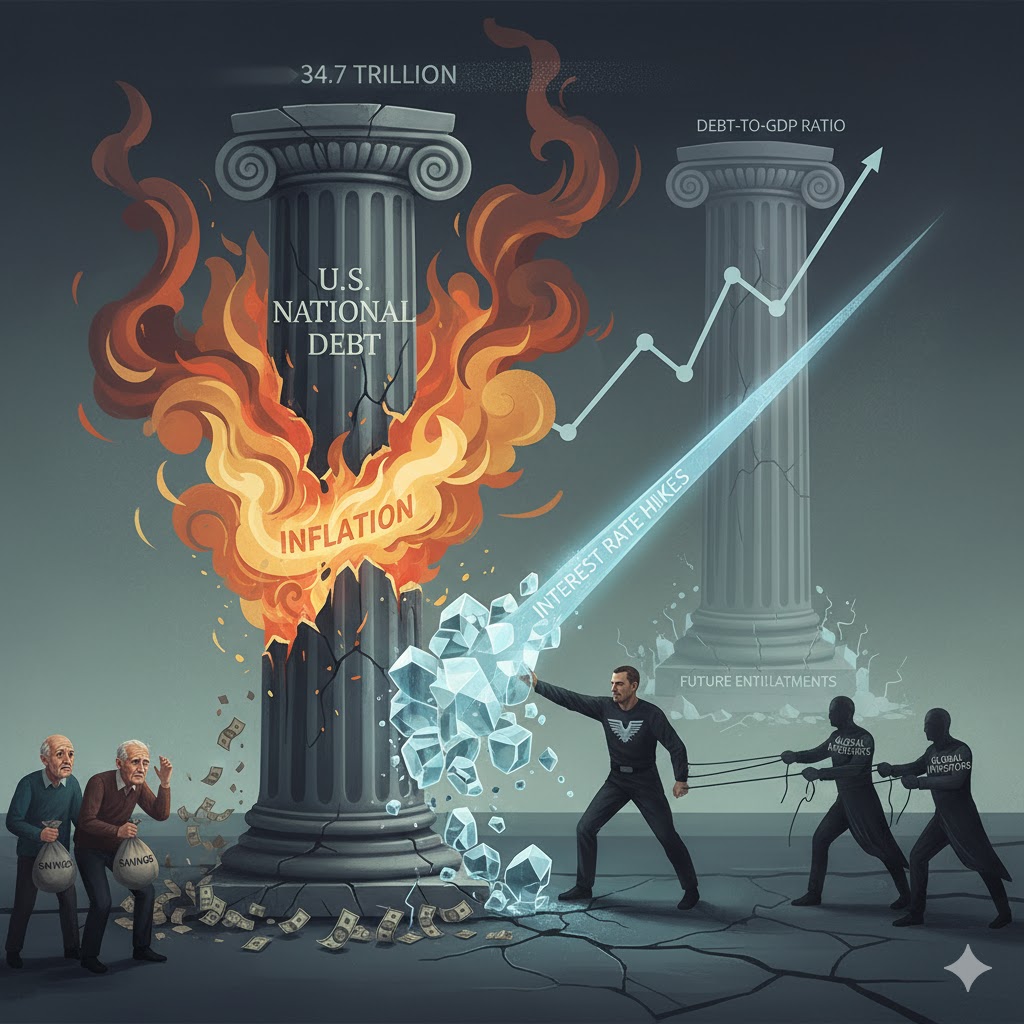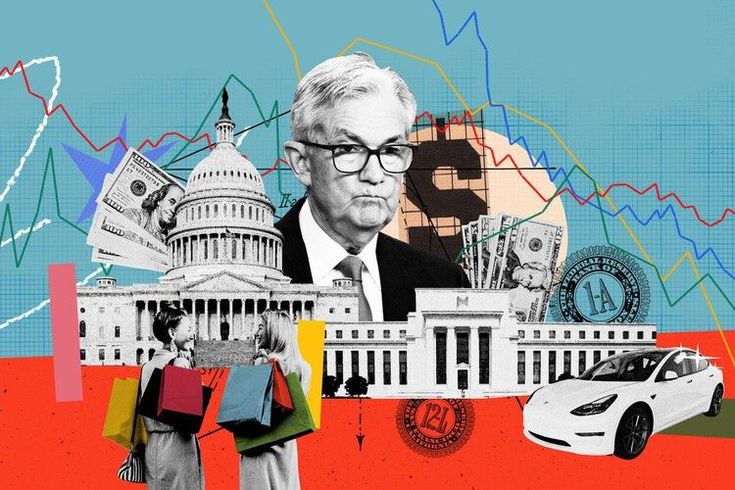Inflation and the U.S. National Debt
A hidden economic lever or a dangerous game? Explore the complex relationship between the value of money and a nation’s borrowing.
How Inflation Erodes Debt
When inflation rises, the real value of fixed debt decreases. The government can pay back its loans with dollars that are worth less than when they were borrowed. Use the slider below to see this effect in action over a 10-year period.
U.S. Economic Dashboard
To understand the scale of the issue, here are the current key metrics driving the conversation around U.S. debt and inflation. These numbers provide the real-world context for the theoretical effects and policy debates.
National Debt
$34.7 Trillion
Source: U.S. Treasury (Approx.)
Annual Inflation (CPI)
3.3%
Source: BLS (Approx.)
Debt-to-GDP Ratio
122%
Source: Federal Reserve (Approx.)
The Great Debate: An Intentional Strategy?
While inflation mechanically reduces debt, the question of whether a government would or should intentionally use it as a policy tool is highly contentious. This section outlines the main arguments for and against this strategy, revealing the significant risks and potential rewards involved.
The Argument FOR Inflating Away Debt
A ‘Silent’ Default
It allows a government to reduce its real debt burden without the politically toxic choices of raising taxes, cutting spending, or explicitly defaulting on its obligations.
Stimulates Growth
The same policies that can lead to inflation (low interest rates, fiscal spending) can also stimulate economic growth, which increases tax revenues and helps lower the debt-to-GDP ratio.
Historical Precedent
After World War II, the U.S. successfully reduced a massive debt load through a combination of strong economic growth and a period of moderate inflation and controlled interest rates.
The Argument AGAINST (The Risks)
Loss of Credibility & Higher Borrowing Costs
If investors suspect a country is intentionally devaluing its debt, they will demand much higher interest rates on future loans, potentially leading to a debt spiral.
Inflation is Hard to Control
“A little” inflation can easily become “a lot.” Uncontrolled inflation creates widespread economic instability, hurts consumers, and wipes out the value of savings, disproportionately affecting the poor and elderly.
Violates Central Bank Mandate
The U.S. Federal Reserve has a dual mandate for price stability and maximum employment. Its primary role is to *fight* inflation, not encourage it, to maintain the long-term health of the economy.
A Historical Perspective
The U.S. has faced high national debt before. The chart below shows the federal debt as a percentage of Gross Domestic Product (GDP), a key indicator of a country’s ability to handle its debt. Notice the dramatic spike from World War II and its subsequent decline, a period often studied in the context of debt management.
Conclusion: A Double-Edged Sword
While inflation does provide a short-term mathematical benefit in reducing the real value of national debt, it is not a viable or intentional long-term strategy for the United States. The profound risks—including loss of investor confidence, soaring future borrowing costs, and the potential for runaway inflation—far outweigh the temporary relief. The Federal Reserve’s primary mandate remains controlling inflation, underscoring that economic stability is prioritized over using inflation as a debt-reduction tool.
The Policy of “Inflating Away the Debt”: A Double-Edged Sword
In the realm of economic policy, “inflating away the debt” stands as a controversial and often debated strategy. It refers to a deliberate policy pursued by a government to reduce the real value of its outstanding debt by generating inflation. This approach, while seemingly a straightforward solution to a nation’s debt burden, is fraught with economic risks and potential long-term consequences.
The Mechanism: How Inflation Diminishes Debt
The core principle behind inflating away debt lies in the distinction between nominal and real values. A government’s debt is typically denominated in its own currency (e.g., U.S. dollars, Japanese yen). When a government incurs debt, it borrows a specific nominal amount. Inflation, which is the rate at which the general level of prices for goods and services is rising, erodes the purchasing power of that currency over time.
Consequently, if a country has a significant amount of fixed-interest debt, a period of unexpected or higher-than-anticipated inflation means that the future repayments of that debt will be made with money that is worth less than when the debt was initially issued. In essence, the government repays its creditors with devalued currency, reducing the real burden of the debt. For this strategy to be effective, the rate of inflation must be higher than the interest rate on the debt.
The Appeal: Potential Benefits
The primary allure of this policy is the potential to alleviate a government’s debt-to-GDP ratio, a key indicator of a country’s economic health. By reducing the real value of its liabilities, a government can free up fiscal space for other expenditures or to avoid unpopular measures such as tax increases or spending cuts. Historically, some economists argue that periods of moderate inflation have coincided with reductions in public debt burdens, particularly after major events like wars that lead to substantial government borrowing.
The Perils: Significant Drawbacks and Risks
Despite its superficial appeal, the deliberate use of inflation to manage debt is a high-stakes gamble with a host of potential negative consequences:
- Erosion of Savings and Fixed Incomes: Inflation indiscriminately erodes the value of all cash holdings and fixed-income investments. This disproportionately affects savers, retirees, and individuals on fixed incomes, whose purchasing power diminishes rapidly.
- Loss of Credibility and Investor Confidence: A government that is perceived to be intentionally devaluing its currency to shirk its debt obligations risks losing the trust of both domestic and international investors. This can lead to higher borrowing costs in the future, as lenders demand a premium to compensate for the anticipated inflation risk. In a worst-case scenario, it could lead to a full-blown debt crisis if investors become unwilling to purchase government bonds.
- Economic Instability and Uncertainty: High and volatile inflation creates a climate of economic uncertainty, making it difficult for businesses and individuals to plan for the future. This can stifle investment, distort price signals, and lead to a misallocation of resources, ultimately hampering economic growth.
- Risk of Hyperinflation: Once unleashed, inflation can be difficult to control. A deliberate policy of inflating away debt could spiral into hyperinflation, a situation of rapid and out-of-control price increases that can decimate an economy and lead to social and political instability.
Historical Precedents and Modern Realities
Historically, there have been instances where inflation has contributed to reducing the real value of public debt. Following World War II, a combination of economic growth and moderate inflation helped many Western countries, including the United States and the United Kingdom, to significantly lower their debt-to-GDP ratios.
However, the economic landscape has changed significantly since then. In today’s globalized financial system, capital is highly mobile, and investors are far more attuned to inflation risks. The independence of central banks in many countries also acts as a bulwark against political pressure to monetize debt and generate inflation.
Furthermore, a significant portion of government debt in many advanced economies now consists of inflation-indexed bonds, which are designed to protect investors from the very policy of inflating away debt.
In conclusion, while the idea of a simple inflationary fix for a nation’s debt problems may be tempting, the reality is far more complex and perilous. The potential for long-term economic damage, loss of credibility, and the erosion of the financial well-being of its citizens make the deliberate policy of “inflating away the debt” a risky and generally discredited strategy in modern economic management. Most economists advocate for more sustainable solutions to high public debt, such as fiscal consolidation, structural reforms to boost economic growth, and prudent monetary policy.



